Kristallnacht
 From Nwe
From Nwe | The Holocaust |
|---|
| Early elements |
| Racial policy · Nazi eugenics · Nuremberg Laws · Forced euthanasia · Concentration camps (list) |
| Jews |
| Jews in Nazi Germany, 1933 to 1939 |
Pogroms: Kristallnacht · Bucharest · Dorohoi · Iaşi · Kaunas · Jedwabne · Lwów |
Ghettos: Warsaw · Łódź · Lwów · Kraków · Theresienstadt · Kovno · Wilno |
Einsatzgruppen: Babi Yar · Rumbula · Ponary · Odessa |
Final Solution: Wannsee · Aktion Reinhard |
Extermination camps: Auschwitz · Belzec · Chełmno · Majdanek · Sobibór · Treblinka |
Resistance: Jewish partisans · Ghetto uprisings (Warsaw) |
End of World War II: Death marches · Berihah · Displaced persons |
| Other victims |
East Slavs · Poles · Roma · Homosexuals |
| Responsible parties |
Nazi Germany: Hitler · Eichmann · Heydrich · Himmler · SS · Gestapo · SA Collaborators Aftermath: Nuremberg Trials · Denazification |
| Lists |
| Survivors · Victims · Rescuers |
| Resources |
| The Destruction of the European Jews Phases of the Holocaust Functionalism vs. intentionalism |
Kristallnacht IPA: [kr,ɪst.aɫ.n'ɒxt] (literally Crystal night[1]) was a pogrom in Nazi Germany on November 9–10, 1938. On a single night, 91 Jews were murdered, and 25,000–30,000 were arrested and deported to concentration camps.[2][3]
The Nazis coordinated an attack on Jewish people and their property in Germany and German-controlled lands as a part of Hitler's anti-Semitic policy.[4]
On November 7, 1938, Herschel Grynszpan, a 17-year old German Jew enraged by his family's expulsion from Germany, walked into the German Embassy in Paris and fired five shots at a junior diplomat, Ernst vom Rath. Two days later, the diplomat died and Germany was in the grip of skillfully orchestrated anti-Jewish violence. In the early hours of November 10, an orgy of coordinated destruction broke out in cities, towns and villages throughout the Third Reich.
The consequences of this violence were disastrous for the Jews of the Third Reich. In a single night, Kristallnacht saw the destruction of more than 1,000 Synagogues, and the ransacking of tens of thousands of Jewish businesses and homes. It marked the beginning of the systematic eradication of a people in Germany who could trace their ancestry to Roman times, and served as a prelude to the Holocaust that was to follow.[5][6]
Context
- For more details on this topic, see History of the Jews in Germany and Nuremberg Laws.
By the end of the 1920s, most German Jews had been assimilated and were relatively prosperous. They served in the German army and contributed to every field of German science, business and culture. The Nazis were elected to power on January 30 1933,[7] although Hitler did not gain absolute power until the Enabling act was passed on March 23, after the Reichstag fire.[8] By 1938, Jews had been almost completely excluded from German social and political life.[9] Many sought asylum abroad, and thousands did manage to leave, but as Chaim Weizmann wrote in 1936, "The world seemed to be divided into two parts–those places where the Jews could not live and those where they could not enter."[10]
Historian Eric Johnson notes that in the year before Kristallnacht, the Germans “had entered a new radical phase in anti-Semitic activity.”[11] Although controversial, some historians believe that the Nazi government had been contemplating a planned outbreak of violence against the Jews for some time and were waiting for an appropriate provocation; there is evidence of this planning that dates back to 1937.[12] The Zionist leadership in Palestine wrote in February 1938 “a very reliable private source–one which can be traced back to the highest echelons of the SS leadership, that there is an intention to carry out a genuine and dramatic pogrom in Germany on a large scale in the near future.”[13]
Timeline of events
Kristallnacht was the result of more than five years and nine months of discrimination and persecution. From its inception in Germany, Hitler's regime moved quickly to introduce anti-Jewish policy. The roughly 500,000 Jews in Germany, who accounted for only 0.76 percent of the overall population,[6] were singled out by the Nazi propaganda machine as the enemy within who were responsible for Germany's defeat in 1918 and her subsequent economic difficulties. The prominence of the Jewish people in the scientific and professional life made them the objects of jealousy which the Nazis skillfully exploited.[6]
During 1933 the German government enacted 42 laws restricting the rights of German Jews to earn a living, to enjoy full citizenship and to educate themselves. The most draconian of these laws, the law "for the reconstruction of the civil service," forbade Jews from working in any branch of the civil service.[14] The pressure against the Jews continued unabated. During 1934, 19 further discriminatory laws were introduced; another 29 anti-Jewish laws were enacted the following year. The most draconian were the Nuremberg Laws "for the protection of German blood and honor." Signed personally by Hitler, these laws prohibited Jews from being citizens of the Reich and forbade marriage between "those of German or related blood" and Jews, Roma (Gypsies), blacks, or their offspring.
In an attempt to provide help to the Jews affected by these laws, an international conference was held on July 6, 1938 on the shores of Lake Geneva. The conference hoped to address the issue of Jewish immigration to other countries. When the conference was held, more than 250,000 Jews had fled Germany and Austria, which had been annexed by Germany in March 1938. However, more than 300,000 German and Austrian Jews were seeking shelter from the oppression. As the number of Jews wanting to leave grew, the restrictions against them also grew with many countries tightening their rule for admission.
Expulsion of Jews from Germany
On October 18, 1938, on Hitler's orders, more than 12,000 Jews were expelled from Germany. They were Polish-born Jews who had been living in Germany, legally, for many years. They were ordered to leave their homes in a single night, and were only allowed one suitcase per person to store their belongings. As the Jews were taken away, all of their remaining possessions were seized as booty by both the Nazi authorities and by their neighbors.
The deportees were taken from their homes to the nearest railway stations, where they were put on trains to the Polish border. Four thousand were granted entry into Poland; however, the remaining 8,000 were forced to stay at the border. There, in harsh conditions, they waited for the Polish government to allow them into the country. Hundreds more, one British newspaper told its readers, "are reported to be lying about, penniless and deserted, in little villages along the frontier near where they had been driven out by the Gestapo and left."[15]
Vom Rath shooting
One expelled couple, who had been living in Hanover for more than 27 years, had a 17-year-old son, Herschel Grynszpan, living in Paris.[5] From the border his sister Berta sent him a postcard describing their expulsion: "No one told us what was up, but we realized this was going to be the end." Her final appeal: "We haven't a penny. Could you send us something…?"[16]
Grynszpan received his sister's short message on November 3. The next day he read a graphic account of the deportations in a Paris Yiddish newspaper. On the morning of Sunday, November 6 he bought a pistol, loaded it with five bullets, and on the following day went to the German embassy where, "in the name of 12,000 persecuted Jews," he shot Ernst vom Rath, fatally wounding him.[16]
Initial Response
On November 8, the first collective punitive measures were announced. All Jewish newspapers and magazines were to cease publication immediately. This ban cut off Jews from their leadership, whose task was to advise and guide them, particularly about emigration. It was a measure, one British newspaper explained, "intended to disrupt the Jewish community and rob it of the last frail ties which hold it together." There were at the time three German Jewish newspapers with a national circulation, four cultural papers, several sports papers, and several dozen community bulletins; the one in Berlin had a circulation of 40,000.[6]
Also on November 8 it was announced that Jewish children could no longer attend "Aryan" state elementary schools, something that had hitherto been allowed where there were not sufficient Jewish elementary schools. At the same time all Jewish cultural activities were suspended "indefinitely."[17]
From the Germans

and was set ablaze on 9 November
1939 by the Nazis
IN KRISTALLNACHT
During the Second World War 1939-1945
it was destroyed by 1943 bombing raids
The façade of this house of God shall
remain forever a site of remembrance
NEVER FORGET
The Jewish Community of Greater Berlin
The Directorate
The reaction of non-Jewish Germans to Kristallnacht was varied. Historian Martin Gilbert believes that “many non-Jews resented the round up,”[18] an opinion supported by German witness Dr. Arthur Flehinger, who recalls seeing “people crying while watching from behind their curtains.”[19] Some even went as far as helping the Jews, but the majority merely sat inside watching in horror, feeling helpless to do anything. Other non-Jewish Germans took part in the violence. Several sources mention women and children participating in the riots, and these were clearly not Stormtroopers but ordinary citizens. Riots broke out on the night of November 7 and continued in some places after the pogrom was called to a halt. The number of German citizens involved in the riots is impossible to know, as many Stormtroopers were wearing civilian clothes and were thus indistinguishable.
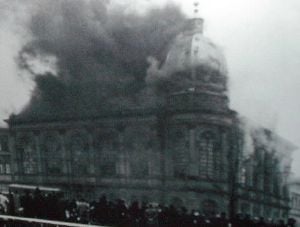
According to Daniel Goldhagen, Bishop Martin Sasse, a leading Protestant churchman, published a compendium of Martin Luther's writings shortly after the Kristallnacht; Sasse "applauded the burning of the synagogues" and the coincidence of the day, writing in the introduction, "On November 10, 1938, on Luther's birthday, the synagogues are burning in Germany." The German people, he urged, ought to heed these words "of the greatest anti-Semite of his time, the warner of his people against the Jews."[20] Diarmaid MacCulloch argued that Luther's 1543 pamphlet On the Jews and Their Lies[21] was a "blueprint" for the Kristallnacht.[22]
In an article released for publication on the evening of November 11, Joseph Goebbels ascribed the events of Kristallnacht to the "healthy instincts" of the German people. He went on to explain: "The German people is anti-Semitic. It has no desire to have its rights restricted or to be provoked in the future by parasites of the Jewish race."[23]
Eyewitness accounts show the general response. Reports of the destruction are the main focus of the article.
"They ripped up the belongings, the books, knocked over furniture, shouted obscenities,"[24]
The scholarly response in that article is very much the same:
"Houses of worship burned down, vandalized, in every community in the country where people either participate or watch,"[24]
There are reports of "destroying… family heirlooms" and many other acts of vandalism.[24]
Response from the Global community
The Kristallnacht pogrom sparked international outrage. It discredited pro-Nazi movements in Europe and North America, leading to eventual decline of their support. Many newspapers condemned Kristallnacht, with some comparing it to the murderous pogroms incited by Imperial Russia in the 1880s. The United States recalled its ambassador (but did not break off diplomatic relations) while other governments severed diplomatic relations with Germany in protest.
As such, Kristallnacht also marked a turning point in relations between Nazi Germany and the rest of the world. The brutality of the pogrom and the Nazi government's deliberate policy of encouraging the violence once it had begun, laid bare the repressive nature and widespread anti-Semitism entrenched in Germany, and turned world opinion sharply against the Nazi regime, with some politicians even calling for war.
Kristallnacht as a turning point
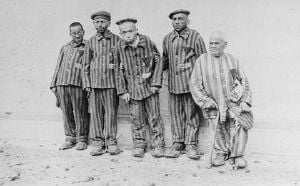
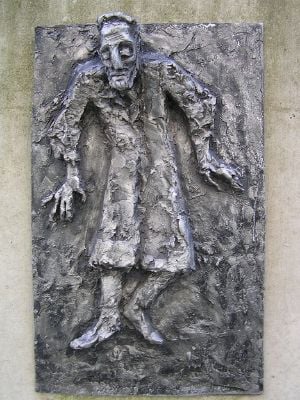
Kristallnacht changed the nature of persecution from economic, political, and social to the physical with beatings, incarceration, and murder; the event is often referred to as the beginning of the Holocaust. In the words of historian Max Rein in 1988, "Kristallnacht came…and everything was changed."[25]
While November 1938 predated overt articulation of "the Final Solution," it nonetheless foreshadowed the genocide to come. Around the time of Kristallnacht, the Schutzstaffel newspaper "Das Schwarze Korps" called for a "destruction by swords and flames." At a conference on the day after the pogrom, Hermann Göring said: "The Jewish problem will reach its solution if, in any time soon, we will be drawn into war beyond our border–then it is obvious that we will have to manage a final account with the Jews."[6]
Specifically, the Nazis managed to achieve in Kristallnacht all the ideological targets they set for themselves: confiscation of Jewish belongings to provide finances for the military buildup to war, separation and isolation of the Jews, and most importantly, the move from the anti-Semitic policy of discrimination to one of physical damage, which began that night and continued until the end of World War II.
The event nonetheless showed the public attitude was not solidly behind the perpetrators. Many Germans at the time found the pogroms troubling, as they equated them with the days of the SA street rule and lawlessness. The British Embassy at Berlin and British Consular offices throughout Germany received many protests and expressions of disquiet from members of the German public about the anti-Jewish actions of the time. The widespread cooperation of ordinary people and the desired severity of atrocities occurred primarily in Vienna and less so in Germany.
Etymology
The incident was originally referred to as die Kristallnacht (literally "crystal night" or the "night of the broken glass"), alluding to the enormous number of shop windows broken that night.[26]
The prefix Reichs- (imperial) was later added (Reichskristallnacht) as a pun on the Nazis' propensity to add this prefix to various terms and titles like Reichsführer-SS (Himmler) or Reichsmarschall (Göring).[27] This was also done in other contexts to ridicule and criticize aspects of the Nazi dictatorship (e.g. Reichswasserleiche - "National Drowned Body" for actress Kristina Söderbaum, who frequently played tragic heroines in her husband Veit Harlan's anti-Semitic melodramas, two of whom committed suicide by drowning.)[28]
Other names
- Reichskristallnacht IPA: [ˈʁaɪç.kr,ɪst.aɫ.n'ɒxt], meaning Imperial crystal night
- Pogromnacht (Russian:погромhо́чь) IPA: [grɐˈmʲitʲ.n'ɒxt], meaning night of havoc and destruction
- Reichspogromnacht (Russian:Рейхпогромhо́чь) IPA: [ˈʁaɪç.grɐˈmʲitʲ.n'ɒxt], meaning Imperial night of havoc and destruction
- Novemberpogrome, (Russian:Ноябрьhо́чь), meaning November night of havoc and destruction
- Crystal Night, literal English translation
- Night of [broken] glass, the meaning of the phrase
Modern Response
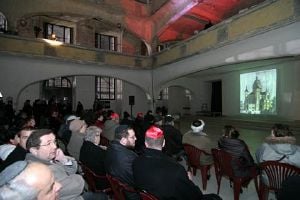
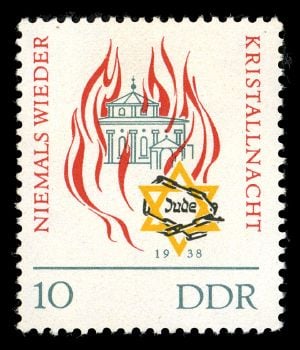
Many decades later, association with the Kristallnacht anniversary was cited as the main reason against choosing November 9 ("Schicksalstag"), the day the Berlin Wall came down in 1989, as the new German national holiday; a different day was chosen (October 3, 1990, German reunification).
Avant-garde guitarist Gary Lucas's 1988 composition "Verklärte Kristallnacht," which juxtaposes the Israeli national anthem, "Hatikvah," with phrases from "Deutschland Über Alles" amid wild electronic shrieks and noise, is intended to be a sonic representation of the horrors of Kristallnacht. It was premiered at the 1988 Berlin Jazz Festival and received rave reviews. (The title is a reference to Arnold Schoenberg's 1899 work "Verklärte Nacht" that presaged his pioneering work on atonal music; Schoenberg was an Austrian Jew exiled by the Nazis).[29]
See also
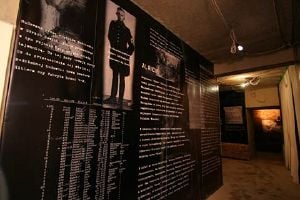
- Anti-Semitism
- Holocaust
- Judaism
- Nazism
- World War II
Notes
- ↑ Kristallnacht - The November 1938 Pogroms United States Holocaust Memorial Museum accessdate 2008-05-20
- ↑ [1] Kristallnacht—Britannica Online Encyclopedia accessdate 2008-05-17
- ↑ November 9/10 1938 - Kristallnacht, the Night of Broken Glass historyplace.com. accessdate 2008-05-19
- ↑ Kristallnacht: Definition and Much More Answers.com accessdate 2008-05-17
- ↑ 5.0 5.1 The Hutchinson Encyclopedia, 1998 ed. (England: Helicon Publishing, ed. 18, 1998, ISBN 1858339510): 1199 chapter "Kristallnacht/"
- ↑ 6.0 6.1 6.2 6.3 6.4 Martin Gilbert. Kristallnacht: Prelude to destruction. (Hammersmith, London: Harper Collins, 2006 ISBN 139780007192403), 23
- ↑ Chris Trueman, Nazi Germany - dictatorship historylearningsite.co.uk. accessdate 2008-03-12
- ↑ Hitler's Enabling Act. historyplace.com. accessdate 2008-03-12
- ↑ The Holocaust.[2]. accessdate 2008-03-12
- ↑ Manchester Guardian, May 23, 1936, cited in A. J. Sherman, Island Refuge, Britain and the Refugees from the Third Reich, 1933–1939. (London: Elek Books Ltd, 1973), 112; also in Annette Shaw,The Evian Conference—Hitler's Green Light for Genocide christianactionforisrael.ort. Retrieved November 5, 2008.
- ↑ Eric Johnson. The Nazi Terror – Gestapo, Jews and Ordinary Germans. (New York: Basic Books, 1999), 117.
- ↑ Saul Friedländer. Nazi Germany and The Jews – Volume 1 – The Years of Persecution 1933-1939. (London: Phoenix, 1997), 270
- ↑ Goerg Landauer to Martin Rosenbluth, 8 February 1938 cited in Friedländer, 1997, 270
- ↑ R.M. Cooper. Refugee Scholars:Conversations with Tess Simpson. Leeds, UK: 1992), 31
- ↑ Expelled Jews' Dark Outlook, Newspaper article. The Times]], 1 November, 1938, accessdate 2008-03-12
- ↑ 16.0 16.1 German State Archives, Potsdam, quoted in Rita Thalmann and Emmanuel Feinermann, Crystal night, 9-10 November 1938, 33, 42
- ↑ Nazis Planning Revenge on Jews, News Chronicle, 9 November, 1938
- ↑ Gilbert, 2006, 70
- ↑ Dr. Arthur Flehinger, “Flames of Fury,” Jewish Chronicle, 9 November 1979, 27, cited in Gilbert, 2006.
- ↑ Bernd Nellessen, "Die schweigende Kirche: Katholiken und Judenverfolgung," in Büttner (ed.), Die Deutchschen und die Jugendverfolg im Dritten Reich, 265, cited in Daniel Goldhagen. Hitler's Willing Executioners. (New York: Vintage, 1997).
- ↑ Martin Luther. The Jews And Their Lies. (Liberty Bell Publications, 2004. ISBN 1593640242)
- ↑ Diarmaid MacCulloch. Reformation: Europe's House Divided, 1490-1700. (New York: Penguin Books Ltd, 2004), 666-667.
- ↑ Daily Telegraph, November 12, 1938. Cited in Gilbert, 2006, 142.
- ↑ 24.0 24.1 24.2 Esther Harris, Gerhard Weinberg, Kristallnacht Remembered www.kold.com. accessdate 2008-05-17
- ↑ Stadt Krefeld, Cited in Eric Johnson. Ehemalige Krefelder Juden berichten uber ihre Erlebnisse in der sogenannten Reichskristallnacht. (New York: Basic Books, Krefeld Stadt Archive, 1988. (Krefelder Juden in Amerika series) volume 3), 117
- ↑ Kristallnacht - Terminology. spiritus-temporis.com. accessdate 2008-05-19
- ↑ The World at War: Herman Goering. euronet.nl. accessdate 2008-05-20
- ↑ Kristina Söderbaum - Biography. IMDb accessdate 2008-05-20
- ↑ Gary Lucas: Action guitarist by Seth Rogovoy. berkshireweb.com. accessdate 2008-05-20 "A knowing reference to Arnold Schoenberg's "Verklarte Nacht," the piece ironically juxtaposed the Israeli national anthem, "Hatikvah," with phrases from "Deutschland Uber Alles," amid wild electronic shrieks and noise. The next day the papers ran a picture of Lucas with the triumphant headline, "It is Lucas!"
References
ISBN links support NWE through referral fees
Books in English
- Browning, Christopher R. 2003. Collected memories: Holocaust history and postwar testimony. (George L. Mosse Series in Modern European Cultural and Intellectual History.) Madison: University of Wisconsin Press. ISBN 0299189848.
- Cooper, R.M. Refugee Scholars:Conversations with Tess Simpson. Leeds, UK: 1992.
- Dawidowicz, Lucy. 1991 (Re-issue). The War Against the Jews: 1933-1945. UK: Bantam. ISBN 978-0553345322.
- Friedlander, Saul 1998. Nazi Germany and the Jews: Volume 1: The Years of Persecution 1933-1939. New York, NY: Perennial. ISBN 0060928786.
- Gilbert, Martin 1986. The Holocaust: the Jewish tragedy. London: Collins. ISBN 0002163055.
- Gilbert, Martin. Kristallnacht: Prelude to destruction. Hammersmith, London: Harper Collins, 2006 ISBN 9780007192403.
- Goldhagen, Daniel. Hitler's Willing Executioners. New York: Vintage, 1997.
- The Hutchinson Encyclopedia, 1998 ed. England: Helicon Publishing, ed. 18, 1998, ISBN 1858339510: 1199 chapter "Kristallnacht"
- Johnson, Eric J. 1999. Nazi terror: the Gestapo, Jews, and ordinary Germans. New York: Basic Books. ISBN 0465049060.
- Luther, Martin. The Jews And Their Lies. Liberty Bell Publications, 2004. ISBN 1593640242. (in English)
- MacCulloch, Diarmaid. Reformation: Europe's House Divided, 1490-1700. New York: Penguin Books Ltd, 2004. ISBN 0713993707
- Mosse, George L. 1978. Toward the Final Solution: A History of European Racism. New York: Howard Fertig. ISBN 0865279411.
- Mosse, George L. 2000. Confronting history: a memoir. Madison: University of Wisconsin Press. ISBN 0299165809.
- Mosse, George L. 2003. Nazi culture: intellectual, cultural and social life in the Third Reich. Madison: University of Wisconsin Press. ISBN 0299193047.
- Mosse, George L. 1999. The Crisis of German Ideology: Intellectual Origins of the Third Reich. New York: Howard Fertig. ISBN 0865274266.
- Schwab, Gerald 1990. The day the Holocaust began: the odyssey of Herschel Grynszpan. New York: Praeger. ISBN 0275935760.
- Sherman, A. J. Island Refuge, Britain and the Refugees from the Third Reich, 1933–1939. London: Elek Books Ltd, 1973.
- Shirer, William L. 1990. The Rise And Fall Of The Third Reich. New York: Simon & Schuster. ISBN 0671728687.
- Yahil, Leni 1990. The Holocaust: the fate of European Jewry, 1932-1945. Oxford [Oxfordshire]: Oxford University Press. ISBN 0195045238
Books in German
- Doscher, Hans-Jurgen 1988. Reichskristallnacht: Die Novemberpogrome 1938. (in German). Ullstein. ISBN 978-3550074950.
- Johnson, Eric. Ehemalige Krefelder Juden berichten uber ihre Erlebnisse in der sogenannten Reichskristallnacht. (New York: Basic Books, Krefeld Stadt Archivive, 1988. (Krefelder Juden in Amerika series) volume 3
- Kaul, Friedrich Karl 1965. Der Fall des Herschel Grynszpan. (in German). Berlin: Akademie-Verl. ASIN B0014NJ88M. Available at Oxford Journals (PDF)
- Lauber, Heinz. 1981. "Judenpogrom: "Reichskristallnacht" November 1938" in Grossdeutschland: Daten, Fakten, Dokumente, Quellentexte, Thesen und Bewertungen. (Aktuelles Taschenbuch) (in German). Bleicher. ISBN 3883500054.
- Pätzold, Kurt & Irene Runge, 1988. Kristallnacht: Zum Pogrom 1938 (Geschichte). (in German). Köln: Pahl-Rugenstein. ISBN 3760912338.
- Pehle, Walter H. 1988. Der Judenpogrom 1938: Von der "Reichskristallnacht" zum Volkermord. (in German). Frankfurt am Main: Fischer Taschenbuch Verlag. ISBN 3596243866.
- Schultheis, Herbert. 1985. Die Reichskristallnacht in Deutschland nach Augenzeugenberichten. (Bad Neustadter Beitrage zur Geschichte und Heimatkunde Frankens) (in German). Bad Neustadt a.d. Saale: Rotter Druck und Verlag. ISBN 3980048233.
External Links
All links retrieved April 25, 2018.
- November 9/10 1938 – Kristallnacht, The Night of Broken Glass
- The Trial of German Major War Criminals
- Kristallnacht: A Nationwide Pogrom
World War II |
|||||
|---|---|---|---|---|---|
Western Europe · Eastern Europe · China · Africa · Mediterranean · Asia and the Pacific · Atlantic |
|||||
Major participants |
Timeline |
Aspects |
|||
|
Principal co-belligerents in italics. |
Prelude 1939 1940 1941 1942 |
1943 1944 1945 • more military engagements Aftermath |
• Attacks on North America Civilian impact and atrocities |
||
| Allies | Axis | ||||
|
at war from 1937 entered 1939 entered 1940 |
entered 1941 entered 1942 entered 1943 entered 1944 • others |
at war from 1937 entered 1939 entered 1940 entered 1941 entered 1942 • others |
|||
| Resistance movements
Austria · Baltic1 · Czechoslovakia · Denmark · Ethiopia · France · Germany · Greece · Italy · Jewish · Netherlands · Norway · Poland · Thailand · USSR · Ukraine2 · Vietnam · Yugoslavia · others |
|||||
1 Anti-Soviet. |
|||||
Credits
New World Encyclopedia writers and editors rewrote and completed the Wikipedia article in accordance with New World Encyclopedia standards. This article abides by terms of the Creative Commons CC-by-sa 3.0 License (CC-by-sa), which may be used and disseminated with proper attribution. Credit is due under the terms of this license that can reference both the New World Encyclopedia contributors and the selfless volunteer contributors of the Wikimedia Foundation. To cite this article click here for a list of acceptable citing formats.The history of earlier contributions by wikipedians is accessible to researchers here:
- Kristallnacht history
The history of this article since it was imported to New World Encyclopedia:
- History of "Kristallnacht"
Note: Some restrictions may apply to use of individual images which are separately licensed.
↧ Download as ZWI file | Last modified: 02/04/2023 07:11:59 | 15 views
☰ Source: https://www.newworldencyclopedia.org/entry/Kristallnacht | License: CC BY-SA 3.0
 ZWI signed:
ZWI signed: KSF
KSF